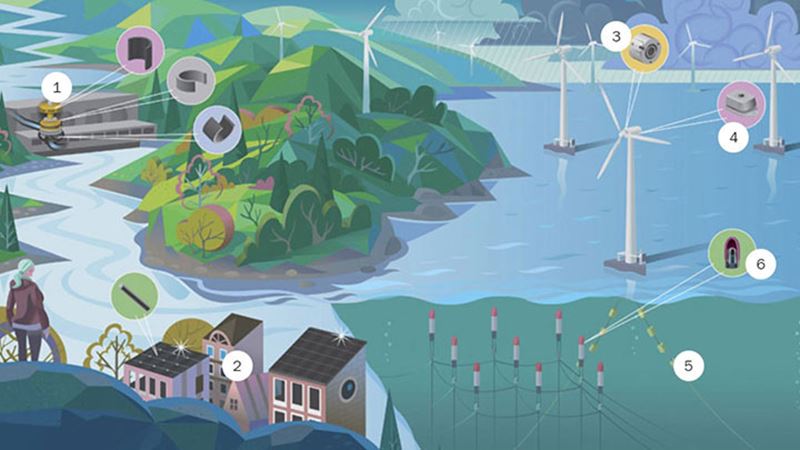Let the sun shine in

Renewable energy has an important role to play in the development of technologies and efforts to address rapid climate change. Almost one-fifth of our energy already comes from renewables and the shift to sustainable solutions continues to grow.
Much of our renewable energy comes from the sun. Alongside other renewables; windpower, hydroelectricity, bioenergy, wave power and geothermal energy are contributing to a sustainable world. While some renewables, such as windpower, have been used for thousands of years, others are emerging technologies. Trelleborg is following the evolution of new technologies closely, as well as the development of more traditional ones, with its buoyancy, sealing, anti-vibration and protective solutions, helping to optimize efficiency. This illustration highlights just a few examples.
Hydropower
1. Orkot bearings are used in many hydropower applications, including lock gates, wicket gates and spillway gates. Made of composites rather than metal, they require no lubricants (making them fish-friendly), have high load capabilities and low water absorption properties.
Solar power
2. Sealing profiles, designed to suit a building’s architecture, keep glass solar panels in position and prevent heat loss or rain from coming in. They also stop the absorption of dust and other particles that could affect the service life of the application.
Wind power
3. Spherilastik bearings work by allowing a wind turbine’s rotor blades to tilt on their hub, counteracting the see-saw motion caused by gusts of wind. They also keep vibration to a minimum.
4. Cushyfloat mounts reduce vibration amplitude, lower structure-borne noise and improve equipment life. NjordGuard stiffener modules protect offshore windfarm power cables. They require only minimal assembly and importantly allow diverless installation and removal. Protecting cables from abrasion and impact, they also reduce the weight of subsea cabling.
5. Distributed Buoyancy Modules (DBMs) are used to protect the subsea electrical power cables that interconnect between turbines. The clamping solution provides uplift and maintains location of the cable. Seals are used within the wind turbine to minimize friction, extend maintenance intervals and ensure zero leakage, while being resistant to temperature extremes, both low and high.
Wave power
6. Trelleborg’s polymer membrane technology is used in wave energy submerged pressure differential devices to ensure the protection of internal components from external water pressure, and act as a bearing to prevent the hull of a vessel and compensation tank from colliding.
This is an article has been reproduced from Trelleborg's T-Time magazine. To download the latest edition, go to: www.trelleborg.com/t-time
Press Service: This article is available in eight languages. Media are welcome to use this article in their own publications. To download the article and pictures in any language go to https://bamboo-contentpartner.com/. If you reproduce information from this release, please give contact details as: www.trelleborg.com.